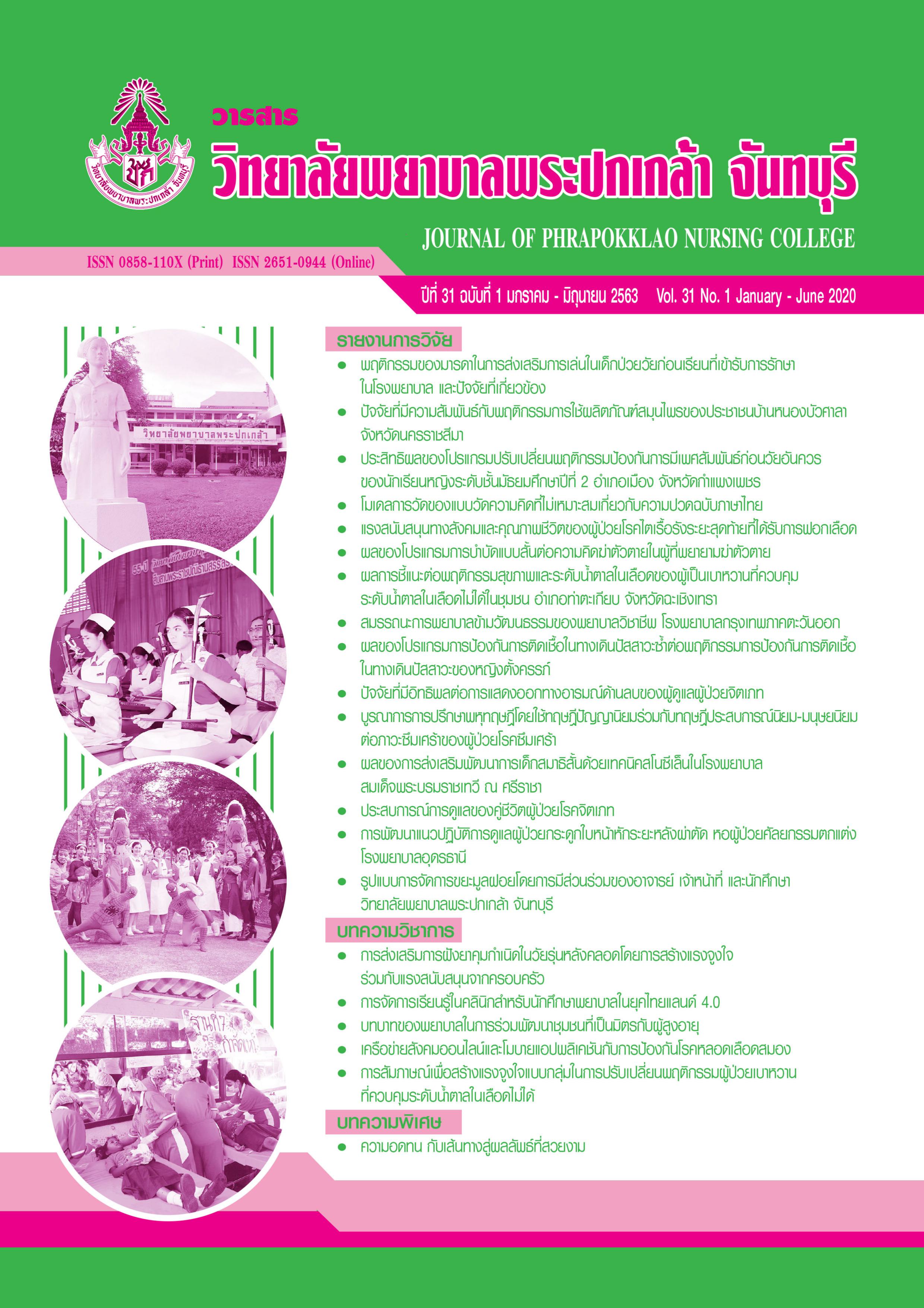Effects of Development Promotion Based on Snoezelen Techniques in Attention-deficit Hyperactivity Disorder (ADHD) Child, Queen Savang Vadhana Memorial Hospital
Keywords:
Development promotion, ADHD child, Snoezelen TechniquesAbstract
This quasi-experimental research aimed to examine effects of development promotion based on Snoezelen Techniques in attention-deficit hyperactivity disorder (ADHD) child. The samples consisted of 24 ADHD child and their parents receiving services at Queen Savang Vadhana Memorial Hospital. The research instruments were composed of the development promotion plan based on Snoezelen Techniques, the equipment based on sensory stimulation with Snoezelen Techniques, the demographic questionnaire, the assessment form of basic development, the assessment form of integration of sensory processing with the reliability of .91, the record form of ADHD child unwanted behaviors, and the record form of ADHD child home behaviors. The implementation and data collection were conducted from December, 2018 to August, 2019. Statistics used for data analysis included frequency, percentage, mean, standard deviation, and paired t-test.
The research results revealed that at the 9th-month after receiving development promotion based on Snoezelen Techniques, ADHD child had statistically significant higher mean scores of five subscales of development than those before receiving development promotion: gross motor skills (t = 7.399, p < .001); fine motor and coordination skills (t = 6.868, p < .001); receptive language and communication (t = 7.439, p < .001); daily living and self-care activities (t = 5.412, p < .001); and social, emotional and behavioral skills (t = 6.261, p < .001). Additionally, it was found that at the 9th-month after receiving development promotion, ADHD child had statistically significant lower mean scores of six subscales of integration of sensory processing than those before receiving development promotion: tactile response (t = 6.660, p < .001); keep balance (t = 6.191, p < .001); movement and vestibular (t = 6.112, p < .001); visual (t = 6.886, p < .001); auditory (t = 8.379, p < .001); and gustatory and olfactory (t = 8.008, p < .001).
This research suggests that health care providers should apply the development promotion plan based on Snoezelen Techniques for promoting development among ADHD child together with others special child.
References
กรมสุขภาพจิต. (2561). กรมสุขภาพจิตพลิกโฉมบริการ รพ.จิตเวชยุคใหม่. สืบค้นจาก http://dmh.go.th/news-dmh/view.asp?id=27799
งานเวชสารสนเทศ โรงพยาบาลสมเด็จพระบรมราชเทวี ณ ศรีราชา. (2561). รายงานสถิติผู้ป่วยจิตเวชเด็กและวัยรุ่น ปี 2559-2561. ชลบุรี: ผู้แต่ง.
เทียม ศรีคำจักร์, และสายฝน ซาวล้อม. (2550). สโนซีเล็น ทฤษฎีสู่การปฏิบัติ. เชียงใหม่: สมพรการพิมพ์.
พรนิภา หาญละคร, สมใจ รัตนมณี, และประกอบ ขันทอง. (2552). ผลของกลุ่มบำบัดแบบพฤติกรรมปัญญานิยมต่อความหวังและความซึมเศร้าในผู้ติดเชื้อเอชไอวี/ผู้ป่วยเอดส์ที่ได้รับยาต้านไวรัส. รามาธิบดีพยาบาลสาร, 15(2), 206-220.
โรงพยาบาลราชานุกูล กรมสุขภาพจิต. (2540). แบบคัดกรองพัฒนาการเด็ก. สืบค้นจาก https://dmh.go.th/test/download/files/developChild.pdf
วินัดดา ปิยะศิลป์. (2550). แนวทางการช่วยเหลือเด็กที่มีปัญหาการเรียน. กรุงเทพฯ: สถาบันสุขภาพเด็กแห่งชาติมหาราชินี กรมการแพทย์.
สำนักสถานพยาบาลและการประกอบโรคศิลปะ กรมสนับสนุนบริการสุขภาพ. (2557). แนวปฏิบัติทางคลินิกกิจกรรมบำบัด สำหรับบุคคลออทิสติกสเปคตรัม. กรุงเทพฯ: อาร์ต ควอลิไฟท์.
สิริพร ศิริฟอง, และปิยะวรรณ ศรีสุรักษ์. (2559). การลดพฤติกรรมไม่อยู่นิ่งของนักเรียนที่มีภาวะออทิสซึม โดยใช้เทคนิคสโนซีเล็นกับการเสริมแรงด้วยเบี้ยอรรถกร. วารสารศึกษาศาสตร์ ฉบับวิจัยบัณฑิตศึกษา มหาวิทยาลัยขอนแก่น, 10(4), 133-137.
อภิศักดิ์ ประสมศรี, สุบิน สาวะธรรม, และกัญญารัตน์ เหล็กมูล. (2554). ผลของการบำบัดรักษาทางกิจกรรมบำบัดโดยใช้เทคนิคสโนซีเล็นที่มีต่อการลดพฤติกรรมซ้ำในเด็กออทิสติกของสถาบันราชานุกูล (รายงานผลการวิจัย). กรุงเทพฯ: สถาบันราชานุกูล.
Frisch, N. C. (2011). Group therapy. In N. C. Frisch & L. E. Frisch (Eds.), Psychiatric mental health nursing (pp. 853-868). Clifton Park, NY: Delmar.
Pajareya, K., & Nopmaneejumruslers, K. (2012). A one-year prospective follow-up study of a DIR/Floortime parent training intervention for pre-school children with autistic spectrum disorders. Journal of the Medical Association of Thailand, 95(9), 1184-1193.
Polanczyk, G., de Lima, M. S., Horta, B. L., Biederman, J., & Rohde, L. A. (2007). The worldwide prevalence of ADHD: A systematic review and metaregression analysis. The American Journal of Psychiatry, 164(6), 942-948.
Polit, D. F., & Hungler, B. P. (1999). Nursing research: Principles and methods (6th ed.). Philadelphia: J. B. Lippincott.
Townsend, M. C. (2005). Essentials of psychiatric mental health nursing (4th ed.). Philadelphia: Davis.
Tripp, G., & Wickens, J. R. (2009). Neurobiology of ADHD. Neuropharmacology, 57(7-8), 579-589.
Downloads
Published
How to Cite
Issue
Section
License
เนื้อความ ข้อมูล และรายการอ้างอิงที่ผู้เขียนใช้ในการเขียนบทความเพื่อลงตีพิมพ์ในวารสารวิทยาลัยพยาบาลพระปกเกล้า จันทบุรี ถือเป็นความคิดเห็นและความรับผิดชอบของผู้เขียน คณะผู้จัดทำวารสารไม่จำเป็นต้องเห็นพ้องด้วยหรือร่วมรับผิดชอบ
บทความที่ได้รับการลงตีพิมพ์ในวารสารวิทยาลัยพยาบาลพระปกเกล้า จันทบุรี ถือเป็นลิขสิทธิ์ของวารสารวิทยาลัยพยาบาลพระปกเกล้า จันทบุรี หากหน่วยงานหรือบุคคลใดต้องการนำส่วนหนึ่งหรือทั้งหมดของบทความไปเผยแพร่ต่อเพื่อวัตถุประสงค์ใด ๆ จะต้องได้รับอนุญาตจากบรรณาธิการวารสารก่อน



